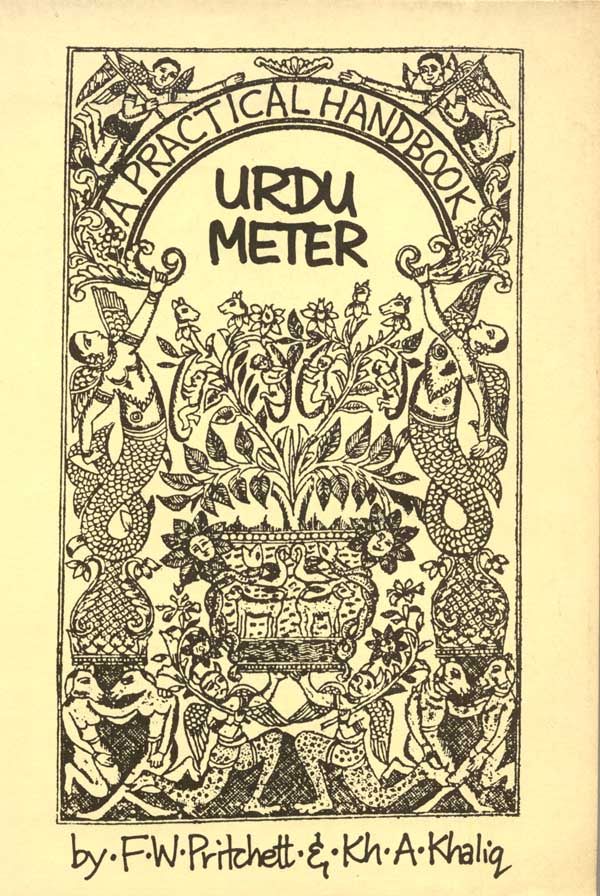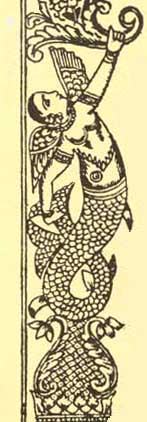~~
INTRODUCTION
TO
THE NEW ONLINE VERSION ~~
We said at the
end of Chapter 8 in the original print edition
(1987) that real ahl-e zabaan were
made and not born. That may have been only partially
the case then, but it's all too true by now.
Traditionally-educated ustads are a dying breed.
Classical Urdu poetry, like so much else, belongs
less and less to those who simply inherit it, and
more and more to those who seek it out and adopt it
for their own.
The very forces
that have deprived us of traditionally-educated
ustads, however, have brought us the internet. Now
Urdu poetry is international, and we can share with
each other across time and space. And of course we
still have Mir and Ghalib, and so much else besides.
So dig in, you ahl-e zabaan of the
future, and learn to use the tools. Classical ghazal
poetry is an astonishing delight. The rewards are so
rich that you won't exhaust them in a lifetime.
Fran Pritchett
New York, July 2003
INTRODUCTION
to
the original print edition (South Asian Studies,
University of Wisconsin at Madison, 1987)
This handbook is designed to be of use to
English-speaking students of Urdu poetry. Above all it
will be helpful to those students for whom English is
a native language. One of the authors is such a
student, while the other has been teaching such
students for years. We have written the kind of book
we can best use ourselves, for our own work; other
students and teachers have also found our approach
helpful. Our method does not assume a native speaker's
instinct, an intuitive perception, or an "ear" for
poetry. Even a completely tone-deaf and unintuitive
student can learn to scan Urdu poetry with great
accuracy. And a student who does have an "ear" can
also learn to hear, recite, and enjoy the oral rhythms
of the poetry as immediately as any native speaker. A
determined student can even compose metrically correct
verse himself; a number of Westerners have done
so.
We do, however, assume the student's ability to
understand the words of a poem in their normal prose
sense, and to pronounce them carefully and correctly.
This does not mean that only advanced students should
study poetry. On the contrary: we feel strongly that
even beginning students can enjoy poetry, and can
profit by exposure to it. But the poetry chosen for
study should be suited to the student's background.
The student who cannot recognize and pronounce most of
the words of a poem, and cannot generally understand
their grammar, cannot properly scan that poem. No
method can enable him to do so, and certainly not
ours. Such a student needs a good dictionary, a good
teacher, or an easier poem; he must generally
understand the poem's words in order to correctly
evaluate its meter.
Another sort of student who can profitably use our
method is the native speaker of Urdu (or the
Hindi-speaker who has learned Urdu script) who has a
serious interest in recitation or composition, but
finds traditional Urdu poetics intimidating. Virtually
all existing accounts of Urdu meter start with the
elaborate metrical systems of Arabic and Persian
poetic theory. These systems are complex enough in
themselves, and must be further modified to suit a
language for which they were not originally intended.
Our method differs from traditional accounts in being
completely descriptive and practical; it is designed
to meet the immediate needs of the student, rather
than to explicate the orthodox system or to develop
any other comprehensive theory. Our method starts with
the poetry as actually encountered, and explains its
scansion in what we think is the simplest and most
efficient way. The native speaker who prefers poetry
to poetic theory will find our handbook convenient.
Finally, we hope that our work will be of interest to
those fully conversant with traditional Urdu poetic
theory. It may offer a few new perspectives, and
suggest different ways of looking at familiar
phenomena.
The first draft of this handbook was compiled during
the course of the Berkeley Urdu Language Program in
Pakistan, 1979-1980, and our earliest debts are to
people associated with that program. The Program owes
its long and healthy career to Professor Bruce Pray of
the University of California at Berkeley, who has been
a friend and counsellor to us both. Dr. Ruth Laila
Schmidt, Field Director for 1979-1980, arranged for us
to have the time and freedom for this project. One of
the Program's teachers, Arif Vaqar, and one of its
participants, Mark S. Pegors, took an especially
strong interest in the project, and their continuing
suggestions and criticisms were most helpful. All
those involved in the Program encouraged us, and
gallantly endured the hours of heated discussion which
we inflicted upon them. In particular we thank Altaf
Fatima, who has been a very good friend to us both,
for her counsel, encouragement, and many cups of
tea.
After the first draft of the book was prepared in
Lahore during 1979-1980, circumstances made it
impossible for the authors to work together in
completing it: Frances Pritchett had to return to the
United States, while Khaliq Ahmad Khaliq remained in
Lahore. The later drafts, including the final one,
were therefore prepared by F. Pritchett after her
return to the United States. Although Khaliq Sahib has
had a chance to see them in a general way, the final
responsibility for the shape of the book, and for any
errors it may contain, must be borne by F. Pritchett.
She thanks all her Urdu students at Columbia
University who have made use of the successive drafts
of this book and contributed their suggestions;
Randolph Thornton in particular has taken a serious
interest in the project.
Above all, the handbook owes incomparably much to the
close scrutiny given it by Shamsur Rahman Faruqi, who
is, among many other distinctions, perhaps the best
modern authority on Urdu meter. Faruqi Sahib was kind
enough to prepare extensive notes which became the
basis for our discussion of feet and meters, and to
suggest appropriate entries for the Bibliography. He
also gave us the benefit of his advice and criticism
throughout. The chance to draw on his specialized
knowledge in this field was invaluable, and we are
most grateful.
We also thank Professor Gopi Chand Narang, of Delhi
University; Professor M. A. R. Barker, of the
University of Minnesota at Minneapolis; and Professor
Ralph Russell, formerly of the School or Oriental and
African Studies of the University of London, for their
most valuable comments and suggestions. Professors
Muhammad Umar Memon and Narayana Rao of the University
of Wisconsin at Madison have also given encouragement
and help to the project. The elegant and beautiful
Urdu script which appears in this volume is generated
by a program called "Khushnavis," designed by
Professor Donald Becker of the University of Wisconsin
at Madison. Professor Becker was most generous with
his help in preparing the manuscript and designing its
printed format, and the book owes him the ultimate
debt: it could not have existed in its present form
without his work.
Frances W. Pritchett
New York, 1987
Khaliq Ahmad Khaliq
Lahore, 1980


